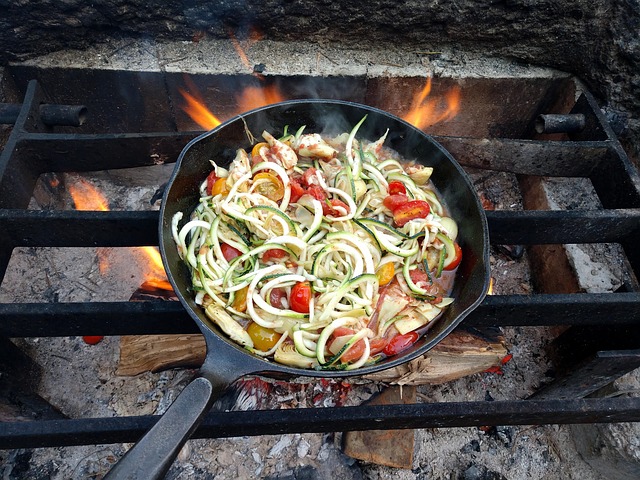Proper ventilation in enclosed spaces like home offices, indoor gardens, and outdoor kitchens is essential for comfort and health. Outdoor kitchens present unique challenges from heat loads and direct sunlight. Strategies include strategic exhaust fans, natural airflow design, and under-floor vents to remove warm air, preventing pollutant buildup. These systems enhance air quality, transform outdoor spaces into enjoyable dining environments, and reduce energy costs by leveraging cross-breezes. Key components are natural ventilation through window and vent placement, efficient airflow, filtration with HEPA filters, periodic opening of windows/doors for dilution, and high-quality exhaust fans or tailored ventilation systems. Regular cleaning maintains optimal air quality in outdoor kitchens.
Proper ventilation and airflow are essential considerations for maintaining comfortable and healthy enclosed areas. This comprehensive guide explores the intricate balance of air circulation, focusing on strategies to meet diverse needs. From understanding ventilation requirements to leveraging outdoor kitchens as airflow boosters, we delve into effective design approaches. Additionally, we offer valuable tips for upholding optimal air quality, ensuring your spaces remain fresh and welcoming. Discover how these tactics can transform enclosed areas, enhancing overall well-being and livability.
- Understanding Ventilation Needs in Enclosed Spaces
- The Role of Outdoor Kitchens in Enhancing Airflow
- Strategies for Effective Ventilation Systems Design
- Maintaining Optimal Air Quality: Tips and Best Practices
Understanding Ventilation Needs in Enclosed Spaces

Proper ventilation is an often-overlooked aspect of creating comfortable and healthy enclosed spaces, be it a home office, indoor garden, or even an outdoor kitchen. Enclosed areas can quickly become stuffy and uncomfortable due to limited airflow, especially when occupied for extended periods. Understanding the specific needs of these spaces is key to maintaining optimal air quality and temperature regulation.
In the case of outdoor kitchens, for instance, ventilation requirements differ from indoor living areas. These spaces often face increased heat load from cooking appliances and direct sunlight exposure. Effective ventilation strategies here might include strategically placed exhaust fans, open-air design elements that facilitate natural airflow, or even under-floor vents to remove warm air and improve overall circulation. Recognizing these needs ensures not only comfort but also prevents the buildup of potentially harmful pollutants and gases, making your enclosed spaces safer and more enjoyable environments.
The Role of Outdoor Kitchens in Enhancing Airflow

Outdoor kitchens play a pivotal role in enhancing airflow and overall ventilation within enclosed areas, such as patios or decks. In many cases, these spaces can become traps for hot air and odors, especially during warmer months. However, incorporating an outdoor kitchen offers a practical solution by introducing a natural flow of fresh air. The strategic placement of cooking appliances and exhaust fans can create a cross-ventilation effect, pushing stagnant air out and drawing in cool, clean air from the outside.
This simple yet effective method not only improves air quality but also creates a more enjoyable dining environment. The open-air setting encourages a connection with nature, allowing for better circulation and a refreshing experience. Moreover, outdoor kitchens can serve as additional living spaces, promoting social interactions and gathering areas that benefit from improved airflow dynamics.
Strategies for Effective Ventilation Systems Design

Effective ventilation systems design involves a multi-faceted approach tailored to specific spaces like outdoor kitchens. One key strategy is to integrate natural ventilation by strategically placing windows and vents to allow for cross-breezes, particularly during cooler parts of the day. This reduces reliance on mechanical systems, lowers energy costs, and enhances overall air quality.
Additionally, designing for efficient airflow includes considering the placement of exhaust fans and vents in relation to cooking areas. In outdoor kitchens, these should be positioned to draw away smoky air and humidity, ensuring a comfortable and healthy environment for users. Filtration systems also play a crucial role, especially in enclosed spaces where airborne contaminants can accumulate. High-efficiency particulate air (HEPA) filters are highly recommended to capture fine particles and allergens, contributing to cleaner and healthier indoor air quality, especially relevant when considering the increased use of outdoor kitchens as extensions of modern living spaces.
Maintaining Optimal Air Quality: Tips and Best Practices

Maintaining optimal air quality in enclosed spaces, such as outdoor kitchens, is paramount for health and comfort. Regularly opening windows and doors allows fresh air to circulate, diluting potential pollutants and ensuring a steady flow of oxygen. This simple practice not only enhances overall well-being but also helps maintain the integrity of kitchen equipment and prevents mold growth, which can be a common issue in enclosed areas with poor ventilation.
In addition to periodic manual ventilation, investing in high-quality exhaust fans or ventilation systems tailored for outdoor kitchens can significantly improve air quality. These devices remove stale air and excess heat, reducing humidity levels. When selecting ventilation solutions, consider factors like coverage area, noise level, and energy efficiency. Regular cleaning and maintenance of these systems are also crucial to ensure optimal performance and to prevent the buildup of dust, bacteria, or other contaminants that can compromise indoor air quality.
Proper ventilation and airflow in enclosed areas, such as homes and buildings, are essential for maintaining optimal air quality. As discussed, understanding specific needs, leveraging outdoor spaces like outdoor kitchens, and implementing effective ventilation systems design are key strategies. By following best practices for maintenance, we can ensure healthy living environments. Incorporating these insights, especially the role of outdoor kitchens, can significantly enhance overall comfort and well-being.
